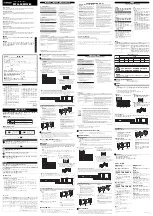
Appendix
F
EU
Directives
F--2
European Union Directives
DL105 PLC User Manual, 3rd Edition
European Union (EU) Directives
NOTE:
The information contained in this section is intended as a guideline and is
based on our interpretation of the various standards and requirements. Since the
actual standards are issued by other parties and in some cases Governmental
agencies, the requirements can change over time without advance warning or notice.
Changes or additions to the standards can possibly invalidate any part of the
information provided in this section.
This area of certification and approval is absolutely vital to anyone who wants to do
business in Europe. One of the key tasks that faced the EU member countries and
the European Economic Area (EEA) was the requirement to bring several similar yet
distinct standards together into one common standard for all members. The primary
purpose of a single standard was to make it easier to sell and transport goods
between the various countries and to maintain a safe working and living
environment. The Directives that resulted from this merging of standards are now
legal requirements for doing business in Europe. Products that meet these
Directives are required to have a CE mark to signify compliance.
As of January 1, 2007, the members of the EU are Austria, Belgium, Bulgaria,
Cyprus, Cxech Republic, Denmark, Estonia, Finland, France, Germany, Greece,
Hungary, Ireland, Italy, Latvia, Lithonia, Luxembourg, Malta, Netherlands, Poland,
Portugal, Romania, Slovakia, Slovenia, Spain, Sweden, and the United Kingdom.
Iceland, Liechtenstein, and Norway together with the EU members make up the
European Economic Area (EEA) and all are covered by the Directives.
There are several Directives that apply to our products. Directives may be amended,
or added, as required.
S
Electromagnetic Compatibility Directive (EMC)
— this Directive
attempts to ensure that products placed on the market do not generate
electromagnetic disturbances that would affect other apparatus,
including radio and/or telecommunications equipment.
S
Machinery Safety Directive
— this Directive covers the safety aspects
of the equipment, installation, etc. There are several areas involved,
including testing standards covering both electrical noise immunity and
noise generation.
S
Low Voltage Directive
— this Directive is also safety related and
covers electrical equipment that has voltage ranges of 50--1000VAC
and/or 75--1500VDC.
S
Battery Directive
— this Directive covers the production, recycling, and
disposal of batteries.
Certain standards within each Directive already require mandatory compliance. The
EMC Directive, which has gained the most attention, became mandatory as of
January 1, 1996. The Low Voltage Directive became mandatory as of January 1,
1997.
Ultimately, we are all responsible for our various pieces of the puzzle. As
manufacturers, we must test our products and document any test results and/or
installation procedures that are necessary to comply with the Directives. As a
machine builder, you are responsible for installing the products in a manner which
will ensure compliance is maintained. You are also responsible for testing any
combination of products that may (or may not) comply with the Directives when used
together.
Member Countries
Applicable
Directives
Compliance
Summary of Contents for DL105
Page 2: ...DL105 PLC User Manual Manual Number D1 USER M...
Page 308: ...1B DL105 Error Codes In This Appendix Error Code Table...
Page 314: ...1C Instruction Execution Times In This Appendix Introduction Instruction Execution Times...
Page 324: ...1D Special Relays In This Appendix DL105 PLC Special Relays...
Page 327: ...1E PLC Memory In This Appendix DL105 PLC Memory...
















































